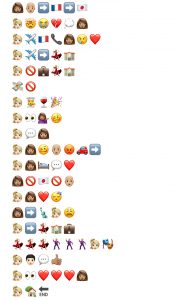

When doing this task, I found it challenging to find a way to symbolize the different characters with the limited “emoji palette” on the iPhone. I ended up watching the film while doing this assignment, trying my best to summarize nuances of the plot as it went along. I think I likely added too many specific plot details that others may not remember if they had watched this movie in the past, and were simply recalling the plot. Additionally, there were elements to the plot that didn’t have a great symbolic emoji (such as a waiter, which is surprising!).
I had to make some compromises to link together emojis to try to communicate the message, and looking back on it now, I can see how the storyline could be misinterpreted by readers. Although I primarily tried to use symbols to communicate the plot, I had to rely on specific emoji’s to represent the actions and emotions of each character: the blonde haired person emoji represents one character, the brown haired person emoji representing another character, etc. Although my intent was to describe the storyline between the characters, a reader of my emoji story may or may not interpret it in the same way. The act of transposing my interpretation of a film’s plot into images, or “reverse-ekphrasis”, as Bolter (2001) called it, leaves quite a bit of room for misinterpretation– in the way I’ve interpreted the plot into words in my mind, selected from a limited palette of emoji’s, and even further as a reader translates these emojis back into thoughts and words in their own minds. Bolter (2001) states “Although the writer and reader may use words to describe and interpret [a] pictorial message, two readers could explain the same message in different words, and speakers of different languages could share the same system of picture writing”, which explains this complexity well.
When choosing a film to use for this task, I didn’t select it based on how easy it would be to visualize. I selected a film that I have watched a few times and really enjoyed as a ‘cult classic’ in my formative years. It’s not a super popular film (although it is currently on Netflix). I think because this film follows a somewhat plausible human storyline, and doesn’t include really specific notable character roles (like super hero/action films generally do), it was much more difficult to transpose into emoji’s. After transposing the film into emoji’s, I then went back and created the title. Only after choosing the specific character emoji’s in the plot could I select the emoji’s for the film’s title. It will make sense if you can guess the film, and you have watched it!
For those that are curious which film this is, I’ve included the title of the film at the end of this blog post in white font. Use your cursor to highlight the space below to see the film’s title.
Frances Ha
Bolter, J. D. (2001). Writing space: Computers, hypertext, and the remediation of print (2nd ed). Lawrence Erlbaum Associates.